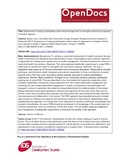Experiences of using a participatory action research approach to strengthen district local capacity in Eastern Uganda
| dc.contributor.author | Tetui, Moses | |
| dc.contributor.author | Coe, Anna-Britt | |
| dc.contributor.author | Hurtig, Anna-Karin | |
| dc.contributor.author | Ekirapa-Kiracho, Elizabeth | |
| dc.contributor.author | Kiwanuka, Suzanne N. | |
| dc.coverage.spatial | uganda | en |
| dc.date.accessioned | 2018-01-23T12:25:19Z | |
| dc.date.available | 2018-01-23T12:25:19Z | |
| dc.date.issued | 2017-08-31 | |
| dc.identifier.citation | Moses Tetui, Anna-Britt Coe, Anna-Karin Hurtig, Elizabeth Ekirapa-Kiracho & Suzanne N. Kiwanuka (2017) Experiences of using a participatory action research approach to strengthen district local capacity in Eastern Uganda, Global Health Action, 10:sup4, 1346038, DOI:10.1080/16549716.2017.1346038 | en |
| dc.identifier.uri | https://opendocs.ids.ac.uk/opendocs/handle/20.500.12413/13494 | |
| dc.description.abstract | Background: To achieve a sustained improvement in health outcomes, the way health interventions are designed and implemented is critical. A participatory action research approach is applauded for building local capacity such as health management. Thereby increasing the chances of sustaining health interventions. Objective: This study explored stakeholder experiences of using PAR to implement an intervention meant to strengthen the local district capacity. Methods: This was a qualitative study featuring 18 informant interviews and a focus group discussion. Respondents included politicians, administrators, health managers and external researchers in three rural districts of eastern Uganda where PAR was used. Qualitative content analysis was used to explore stakeholders’ experiences. Results: ‘Being awakened’ emerged as an overarching category capturing stakeholder experiences of using PAR. This was described in four interrelated and sequential categories, which included: stakeholder involvement, being invigorated, the risk of wide stakeholder engagement and balancing the risk of wide stakeholder engagement. In terms of involvement, the stakeholders felt engaged, a sense of ownership, felt valued and responsible during the implementation of the project. Being invigorated meant being awakened, inspired and supported. On the other hand, risks such as conflict, stress and uncertainty were reported, and finally these risks were balanced through tolerance, risk-awareness and collaboration. Conclusions:The PAR approach was desirable because it created opportunities for building local capacity and enhancing continuity of interventions. Stakeholders were awakened by the approach, as it made them more responsive to systems challenges and possible local solutions. Nonetheless, the use of PAR should be considered in full knowledge of the undesirable and complex experiences, such as uncertainty, conflict and stress. This will enable adequate preparation and management of stakeholder expectations to maximize the benefits of the approach. | en |
| dc.language.iso | en | en |
| dc.publisher | Taylor & Francis | en |
| dc.rights | This is an Open Access article distributed under the terms of the Creative Commons Attribution License (http://creativecommons.org/licenses/by/4.0/), which permits unrestricted use, distribution, and reproduction in any medium, provided the original work is properly cited. | en |
| dc.rights.uri | http://creativecommons.org/licenses/by/4.0/ | en |
| dc.subject | Children and Youth | en |
| dc.subject | Health | en |
| dc.subject | Participation | en |
| dc.title | Experiences of using a participatory action research approach to strengthen district local capacity in Eastern Uganda | en |
| dc.type | Article | en |
| dc.rights.holder | © 2017 The Author(s). Published by Informa UK Limited, trading as Taylor & Francis Group. | en |
| dc.identifier.externaluri | http://www.tandfonline.com/doi/full/10.1080/16549716.2017.1346038 | en |
| dc.identifier.team | Health and Nutrition | en |
| dc.identifier.doi | 10.1080/16549716.2017.1346038 | |
| dcterms.dateAccepted | 2017-06-19 | |
| rioxxterms.funder | Default funder | en |
| rioxxterms.identifier.project | Future Health Systems | en |
| rioxxterms.version | VoR | en |
| rioxxterms.versionofrecord | https://doi.org/10.1080/16549716.2017.1346038 | en |
| rioxxterms.funder.project | 50c0b576-b4b1-402e-a6cd-50d73c1d4430 | en |
Files in this item
This item appears in the following Collection(s)
Except where otherwise noted, this item's license is described as This is an Open Access article distributed under the terms of the Creative Commons Attribution License (http://creativecommons.org/licenses/by/4.0/), which permits unrestricted use, distribution, and reproduction in any medium, provided the original work is properly cited.


